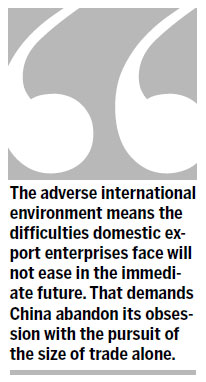Foreign trade prospects
By Zhou Junsheng (China Daily) Updated: 2013-04-19 07:13
China must accelerate pursuit of technological innovations and improve product quality to compete in global market
Despite a recent export and import recovery, China still needs to improve the quality of its exports as a way to boost its struggling foreign trade in the international market where there are lingering uncertainties.
China's import and export volumes totaled 6.12 trillion yuan ($975 billion) in the first quarter, an increase of 13.4 percent year-on-year, statistics from the General Administration of Customs indicate. Of the total value, exports accounted for 3.2 trillion yuan, up 18.4 percent on the previous year, while imports rose by 8.4 percent to 2.9 trillion yuan. The trade surplus in the three months also increased from less than 1.3 billion yuan during the same period of last year to 270.5 billion yuan.
The government has long regarded expanding foreign trade and investment as two major drivers of growth in the context of China's insufficient domestic demand. But with the expansion of investment growing increasingly unstable in recent years, the government has shifted its macroeconomic focus to boosting domestic demand. However, it has made little substantial progress, so it still hopes that foreign trade will be able to bolster the country's economic growth.
The first-quarter foreign trade growth came amid a continuous decline since the onset of the global financial crisis, and it is indeed good news to China's decelerating economy, as its full-year foreign trade grew by only 6.2 percent in 2012.
However, such a good-looking bounce doesn't mean China has completely extricated itself from the downturn of recent years, as it is an upswing from the lower volume of foreign trade experienced in the last few years as a result of the serious international market contractions caused by the global financial crisis. In this sense, the first-quarter growth should be regarded as a recovery; it remains to be seen whether the momentum can be maintained.
The sluggish global recovery will be a drag on China's efforts to expand exports. Due to several rounds of quantitative easing, demand in the United States has rebounded, which has to some extent promoted increased exports from China to the US, and last year the US replaced the European Union as the largest market for Chinese exports. Many countries in the EU are still plagued by a sovereign debt crisis, causing a continuous decline in their purchasing power and demand for Chinese products. Meanwhile, the ongoing dispute with Japan over the Diaoyu Islands has caused a decline in bilateral trade with another major trading partner.











